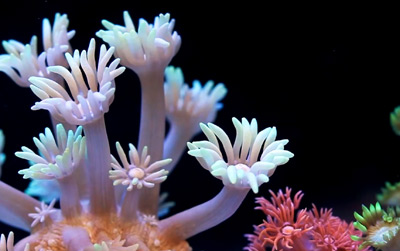Carbon dosing is a relatively new phenomenon in the reef aquarium hobby. The first I heard about it was around two years ago, and I hadn’t given it a whole lot of thought until recently. The goal of carbon dosing is to improve water quality by lowering nitrates and phosphates. Nitrates and phosphates can lead to algae blooms and poor coral health if the levels are too high. Some aquarists have difficulty controlling these levels and it can be a frustrating battle.
Carbon dosing lowers these two chemical parameters by providing a food source for bacteria that consume nitrates and phosphates. Then, by removing the bacteria through protein skimming, the aquarist eliminates nitrates and phosphates from the water. It is similar in concept to algae scrubbing, whereby one grows algae to bind up phosphate, nitrate, and heavy metals, and then exports them from the system by periodically harvesting the algae. In a carbon-dosing system, bacteria are removed instead of algae.
For the longest time, I paid little attention to carbon dosing because I did not have detectable quantities of either phosphates or nitrates. This is not so much a boast as it is the reality of having a 1,000-gallon system with very few fish in it. There just aren’t a lot of ways for nitrates and phosphates to build up. Why attempt to fix a non-problem, after all? Having said that, there could be some benefits to carbon dosing even though the system already has low nitrates and phosphates.
Extra feeding capacity
The first advantage to carbon dosing is it allows the reefkeeper to feed much more heavily. I am of the firm belief that most of our tanks are underfed and both the fish and invertebrates would fare better if fed more frequently (and in higher quantities). The limitation is the filtration capacity of the system. If the filtering capacity of your system is exceeded, heavy feeding can cause a buildup of nutrients that will lead to poor water quality. Bolstering the filtration capacity of your reef through carbon dosing allows you to feed that much more into the system.
Bacterial nutrition
The second benefit is that the bacteria themselves contribute to invertebrate nutrition. If you have ever heard of the term “reef snow,” it is in reference to bacteria colonies growing on particulates that provide nutrition to countless marine organisms. I’ve recently learned that bacteria might comprise far more nutrition than originally thought. In fact, bacteria alone could provide ALL the nutritional requirements of coral. Not only do bacteria provide nitrogen and carbon for the coral, but they also provide phosphorous and trace elements for the corals’ zooxanthellae.
Many of my coral videos focus on feeding corals, and some corals, such as Goniopora, are notoriously difficult to feed. For these finicky eaters, the key may be to focus less on trying to feed seafood products and more on providing healthy populations of bacteria as a food source.
Ultra-low-nutrient voodoo
It’s somewhat questionable whether the third benefit is actually, well, beneficial. Carbon dosing can provide an ultra-low-nutrient environment. In ultra-low-nutrient systems, corals, especially SPS corals such as Acropora, Montipora, Pocillopora, Porites, etc., can take on exaggerated coloration. Some corals get insanely bright.
It is unclear at this time whether this is a healthy sign or not. Many times, the coral specimens that we think are the most aesthetically pleasing are actually the least healthy. Case in point: some of the most incredible Euphyllia I have ever seen were bleached colonies that had a ghostly translucent appearance. Once restored to health, they regained their brownish-green hue.
Carbon dosing downsides
Unfortunately, there are downsides to carbon dosing. Some aquarists run into issues with unsightly forms of bacteria proliferating. Chief among these are brown diatoms and red slime algae, which is a type of cyanobacteria.
For now, I intend to experiment with carbon dosing in the form of vodka dosing. There are other methods, such as vinegar, sugar, biopellets, and manufactured carbon products from a number of vendors.



